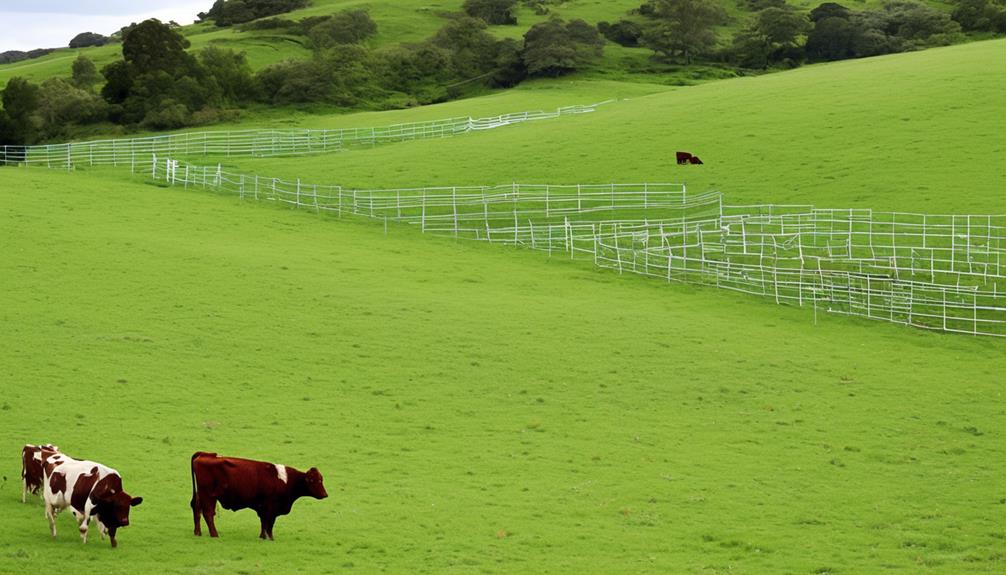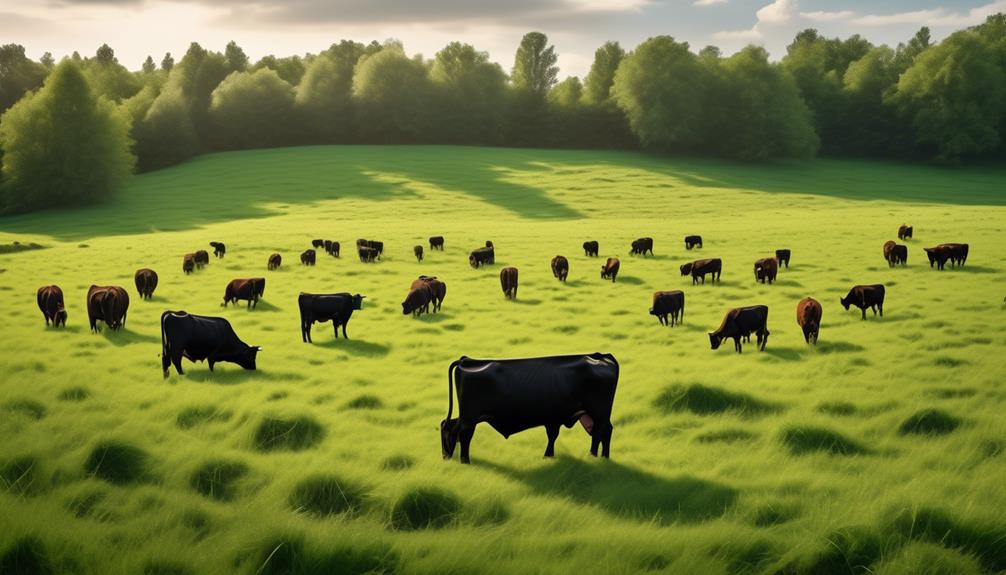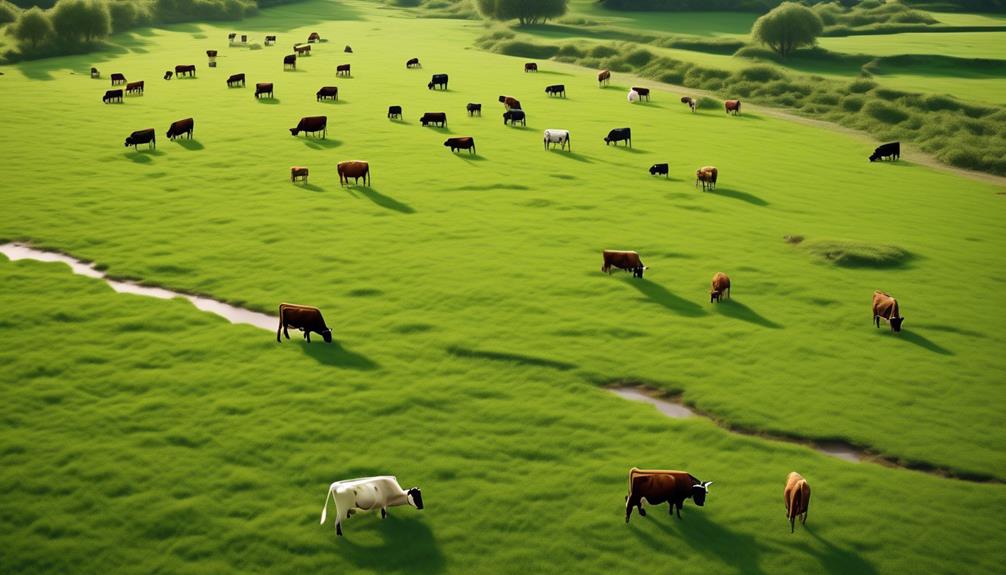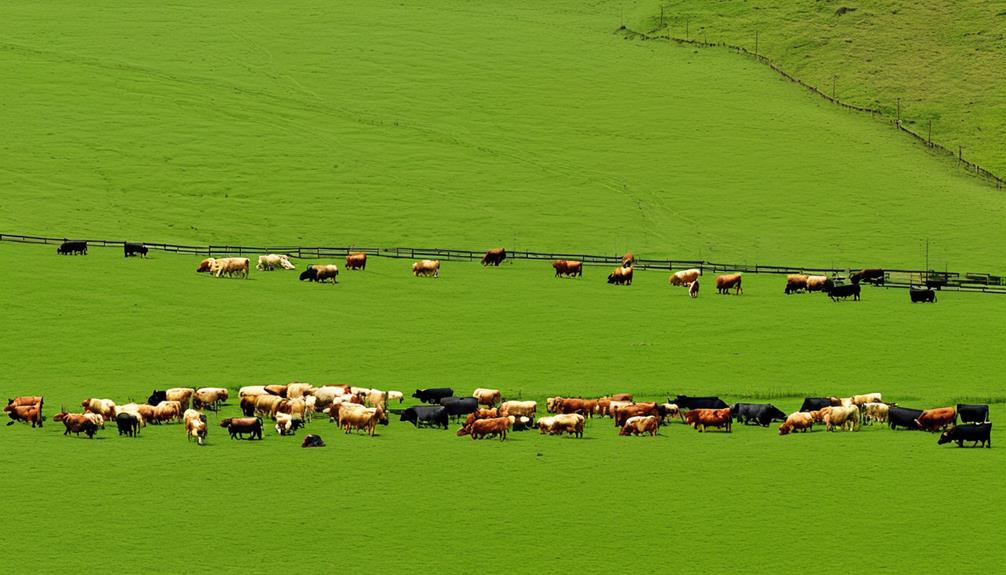Why Is Rotational Grazing Essential for Sustainable Cattle Production?
You may think that rotational grazing is just another farming practice, but let me tell you, it's the absolute cornerstone of sustainable cattle production.
The impact it has on the health of your herd and the land they graze on is nothing short of remarkable. From soil health to parasite control, the benefits are far-reaching and essential for the long-term success of your operation.
But why exactly is rotational grazing so crucial? Well, let's just say that it's not just about the grass your cattle munch on.
Benefits of Rotational Grazing

With rotational grazing, cattle are able to access fresh, high-quality forage regularly, leading to improved health and weight gain. This practice involves dividing pastures into smaller sections and rotating the cattle through these areas at specific intervals. By doing so, you maximize productivity as the grazing pressure is evenly distributed, allowing for uniform forage utilization and promoting regrowth. Sustainable land management is achieved through rotational grazing as it prevents overgrazing in specific areas and allows for natural regeneration of the pasture.
Implementing rotational grazing has shown to have numerous benefits for both the cattle and the land. Cattle are able to consume the most nutritious parts of the forage, resulting in better weight gain and overall health. Moreover, the constant movement of the cattle helps in evenly distributing their manure, which in turn improves soil fertility. This promotes sustainable land management by maintaining the health of the pasture and reducing the need for external inputs like fertilizers.
Furthermore, this method also minimizes soil erosion and compaction, as the cattle aren't continuously concentrated in one area. As a result, the land remains healthier and more productive over time. By practicing rotational grazing, you aren't only ensuring the well-being of your cattle but also contributing to sustainable land management, making it a win-win situation for both the livestock and the environment.
Improving Soil Health
Maximizing productivity through rotational grazing not only benefits your cattle but also plays a crucial role in improving soil health. By implementing this practice, you can significantly enhance soil fertility and control erosion on your grazing land.
Here's how rotational grazing contributes to improving soil health:
- Enhanced Soil Fertility:
Rotational grazing allows for periods of rest for specific grazing areas, enabling vegetation to recover and build up organic matter in the soil. As a result, the soil becomes more fertile, promoting better pasture growth and overall ecosystem health.
- Reduced Erosion:
The controlled movement of cattle in rotational grazing prevents overgrazing in one area, which can lead to soil erosion. By allowing the soil to rest and recover, the risk of erosion is minimized, preserving the integrity of the land.
- Nutrient Cycling:
Rotational grazing facilitates better nutrient cycling in the soil. As cattle move through different paddocks, their waste is distributed more evenly, returning essential nutrients to the soil and promoting healthier pasture growth.
- Improved Water Infiltration:
Rotational grazing promotes healthier root systems in the pasture, which in turn enhances water infiltration and reduces runoff. This helps maintain soil moisture levels and prevents erosion by minimizing the impact of heavy rainfall.
Incorporating rotational grazing into your cattle management practices isn't only beneficial for your livestock but also contributes significantly to maintaining and improving the health of your grazing land.
Optimizing Forage Utilization

To optimize forage utilization, consider implementing strategic grazing practices that promote efficient use of available pasture resources. Maximizing productivity and minimizing waste are crucial for sustainable cattle production. One effective method to achieve this is through rotational grazing, which involves dividing pastures into smaller paddocks and rotating cattle between them. This allows forage to recover in previously grazed areas while ensuring a continuous supply of fresh, high-quality feed for the cattle.
By rotating cattle to new paddocks frequently, you can prevent overgrazing and give the forage plants ample time to regrow. This not only maximizes productivity by maintaining a healthy and diverse forage stand but also minimizes waste by reducing the risk of trampling or selective grazing. Additionally, implementing rest periods for pastures after grazing ensures that plants have the opportunity to replenish their energy reserves and root systems, further contributing to optimal forage utilization.
Another way to optimize forage utilization is by adjusting stocking rates based on forage availability and growth rates. This proactive approach prevents overgrazing, leading to improved forage quality and quantity. Monitoring forage utilization through tools like pasture height measurements and grazing charts can help you make informed decisions about when to rotate cattle and when to rest specific paddocks.
Reducing Environmental Impact
Consider implementing rotational grazing practices to not only optimize forage utilization but also reduce the environmental impact of cattle production. By adopting this approach, you can significantly contribute to water conservation, nutrient management, wildlife habitat preservation, and carbon sequestration.
- Water conservation, nutrient management: Rotational grazing helps in water conservation by allowing pastures to rest and recover, which reduces soil erosion and improves water infiltration. This method also aids in nutrient management by preventing overgrazing, which can lead to soil nutrient depletion and water pollution.
- Wildlife habitat: Rotational grazing creates diverse grasslands, benefitting various wildlife species. The rotational pattern provides periods of rest for different sections of the pasture, allowing vegetation to grow and serve as habitats for insects, birds, and small mammals.
- Carbon sequestration: Proper grazing management through rotation encourages healthier grass growth. This, in turn, promotes the capture and storage of carbon in the soil. By sequestering carbon, rotational grazing contributes to mitigating the effects of greenhouse gases on the environment.
Enhancing Pasture Resilience

Improving pasture resilience is essential for ensuring sustainable cattle production and maintaining healthy grazing lands. Drought resistance is a critical aspect of enhancing pasture resilience. With changing climate patterns, it's crucial to implement grazing management strategies that support the development of drought-resistant pastures.
Rotational grazing, which involves moving cattle between different paddocks, allows for better pasture recovery during dry periods. By rotating the grazing areas, you can prevent overgrazing and give the pastures time to rest and rejuvenate, ultimately enhancing their ability to withstand drought conditions.
Another vital element in enhancing pasture resilience is promoting biodiversity. Implementing pasture rotation not only prevents overgrazing but also encourages the growth of diverse plant species. This diversity makes pastures more resilient to environmental stressors and provides a more balanced diet for the cattle.
Furthermore, a varied plant community can improve soil health, water retention, and overall pasture productivity. By incorporating legumes, grasses, and other forage species into the rotation, you can enhance the resilience of the pasture ecosystem.
Managing Parasite Control
When managing parasite control in rotational grazing systems, regularly monitor the health of your cattle and promptly address any signs of parasitic infestation. Parasites can significantly impact the well-being of your herd and hinder their productivity.
To effectively manage parasite control in your rotational grazing system, follow these essential steps:
- Establish a Grazing Schedule: Implement a strategic grazing schedule to prevent overgrazing and reduce the risk of parasite transmission. Rotational grazing allows for periods of rest and recovery for pastures, which can help break the parasite life cycle and decrease the overall parasite load in the environment.
- Practice Fecal Egg Counts: Regularly conduct fecal egg counts to assess the parasite burden in your cattle. This practice can help you make informed decisions about parasite control measures and monitor the effectiveness of your current parasite management strategies.
- Rotate Grazing Areas: Rotating grazing areas can help minimize parasite exposure by allowing pastures to rest and parasites to die off between grazing periods. This practice can also reduce the build-up of parasite larvae in specific areas, lowering the risk of infestation for your cattle.
- Consider Parasite Resistance: When implementing parasite control measures, consider the potential for parasite resistance to certain dewormers. Rotational grazing can help mitigate this issue by reducing the reliance on chemical treatments and promoting a more balanced and sustainable approach to parasite control.
Increasing Carrying Capacity

To enhance the overall productivity and sustainability of your rotational grazing system, maximizing the carrying capacity of your pastures is essential. Grazing management plays a crucial role in increasing carrying capacity and is a key component of sustainable practices. By strategically managing the movement of livestock across your pastures, you can optimize forage utilization and promote regrowth, ultimately allowing for an increased number of animals to be sustained on the land.
Effective grazing management involves dividing pastures into smaller paddocks and rotating livestock through these areas. This approach allows for adequate rest periods for the vegetation, preventing overgrazing and promoting healthier regrowth. By implementing rotational grazing, you can ensure that forage resources are utilized more efficiently, leading to an overall increase in carrying capacity. Additionally, the practice of rotational grazing helps to minimize soil compaction and erosion, contributing to the long-term sustainability of your grazing operation.
Furthermore, proper grazing management can also lead to improvements in soil health and nutrient cycling. By allowing vegetation to recover through rotational grazing, the root systems of plants become stronger, enhancing their ability to access water and nutrients from the soil. This, in turn, leads to improved forage production and quality, further supporting an increased carrying capacity for your pastures.
Incorporating sustainable grazing practices into your rotational grazing system won't only benefit the land and its productivity but also contribute to the economic viability of your cattle production in the long run.
Improving Cattle Performance
Maximize cattle performance through strategic feeding and health management practices, ensuring optimal productivity and overall herd well-being. To improve cattle performance, consider the following:
- Nutritional Management: Implement a balanced and nutrient-rich diet tailored to meet the specific needs of your herd. Ensure access to high-quality forage, supplemented with minerals and vitamins as needed. Monitor body condition scores and adjust feed rations accordingly to maintain ideal body condition and support reproductive performance.
- Grazing Behavior: Understand the natural grazing behavior of cattle and leverage rotational grazing to optimize forage utilization and minimize selective grazing. By rotating cattle through different pastures, you can allow forage to rest and regenerate, leading to improved nutrient intake and overall herd health. Additionally, observing grazing patterns can provide valuable insights into herd health and preferences, allowing for targeted management strategies.
- Health Monitoring: Regularly monitor the health of your cattle to address any potential issues promptly. Implement a vaccination and parasite control program in consultation with a veterinarian to prevent disease outbreaks and minimize production losses.
- Water Provision: Ensure easy access to clean and fresh water sources throughout the grazing areas. Adequate hydration is essential for cattle performance, particularly during hot weather or lactation, and can significantly impact overall productivity and well-being.
Frequently Asked Questions
How Does Rotational Grazing Affect the Biodiversity of the Pasture Ecosystem?
Rotational grazing promotes soil fertility and plant diversity by allowing forage to recover between grazing periods. It impacts grazing behavior positively, creating varied wildlife habitats, which, in turn, enhances the biodiversity of the pasture ecosystem.
What Specific Rotational Grazing Methods Are Most Effective for Different Types of Cattle and Environments?
When it comes to grazing management, different cattle types and environments require specific rotational grazing methods. These methods directly impact cattle behavior, pasture productivity, and soil health. Understanding these factors is crucial for sustainable cattle production.
How Does Rotational Grazing Impact the Overall Carbon Footprint of Cattle Production?
Rotational grazing reduces emissions by preventing overgrazing and improving soil health. It allows for better carbon sequestration and reduces the overall carbon footprint of cattle production. You'll see positive impacts on the environment.
Can Rotational Grazing Help Prevent or Reduce the Spread of Diseases Among Cattle?
Rotational grazing, with proper grazing management, can help prevent diseases among cattle by reducing overgrazing and minimizing exposure to parasites. It allows for better sanitation and natural pasture recovery, promoting healthier livestock.
What Are Some Potential Challenges or Drawbacks of Implementing Rotational Grazing in Cattle Production?
Implementing rotational grazing in cattle production may pose challenges such as initial setup costs and labor requirements. Drawbacks include potential environmental impact and the need for careful management to maintain soil health.
Conclusion
In conclusion, rotational grazing is essential for sustainable cattle production. It offers numerous benefits such as:
- Improving soil health
- Optimizing forage utilization
- Reducing environmental impact
- Enhancing pasture resilience
- Managing parasite control
- Increasing carrying capacity
- Improving cattle performance
By implementing rotational grazing practices, you can ensure the long-term sustainability of your cattle operation while also improving the overall health of your pastureland.
